Looduskalender in Vikerraadio: Raccoon dogs on the road
The author, Kristel Vilbaste, also posts texts in Vikerraadio
Photos: Arne Ader
Translation into English by Maret
Estonian text posted 22.08.2018
Raccoon dog
Driving around these days you will notice lots of raccoon dog corpses on the roads. Most likely even you yourself have had to do some zig-zag driving in order to save the life of a little animal.
The mention of raccoon dogs usually does not raise any positive emotions in us, probably because of the song, where they as a foreign species crowded out the badgers. Still, they were brought in decades ago for reasons of vanity, as a hat made of raccoon dog skins was a sign of prosperity. Many people were dreaming of such a nice hat or a fur collar, although once that skin got wet, it smelled something awful.
Just because of that smell, the animals killed on the roads are left there - the other predators will not touch them.

 Latest news
Latest news Loodusemees.ee - the day in pictures
Loodusemees.ee - the day in pictures Videos
Videos
 My Forest
My Forest






